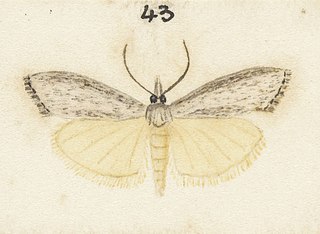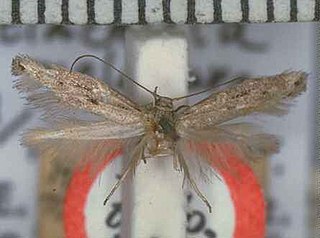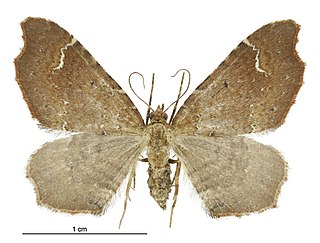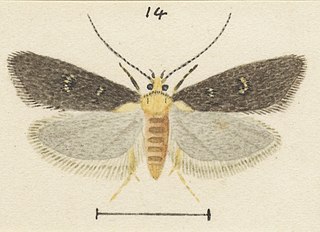Related Research Articles

Maoricrambus is a genus of moths of the family Crambidae. It contains only one species, Maoricrambus oncobolus, which is endemic to New Zealand. This species is classified as Nationally Endangered by the Department of Conservation.

Thectophila is a genus of moths in the family Cosmopterigidae, although some sources place it in the family Blastodacnidae. The genus contains only one species, Thectophila acmotypa. This species is endemic to New Zealand. It is classified as "Data Deficient" by the Department of Conservation.

Bascantis is a genus of moths belonging to the family Tineidae. It contains only one species, Bascantis sirenica, that is endemic to New Zealand. This species is classified as "Data Deficient" by the Department of Conservation.

Stigmella progama is a species of moth in the family Nepticulidae. This species is endemic to New Zealand. It is classified as "Data Deficient" by the Department of Conservation. S. progama has only been collected on Bold Peak in Otago.

Zealandopterix zonodoxa is a moth of the family Micropterigidae. It endemic to New Zealand and is found from the Hawkes Bay north as well as on Poor Knights, Little Barrier and Great Barrier Islands. It is the smallest micropterigid in New Zealand and the shiny white markings on the forewing of this species are variable. It is a day flying moth, but has been collected using UV light. Adults are on the wing from September to March and the species has been witnessed visiting the flowers of Nikau and Cordyline pumilio in large numbers. It inhabits a wide variety of moist indigenous forest but is associated with forests in which podocarps are common. Larvae have been sieved from rotten wood on the floor of a mixed podocarp/broadleaf forest or extracted from moss or from bryophytes.

Izatha apodoxa is a moth of the family Oecophoridae. It is endemic to New Zealand, where it is known from scattered localities in the southern North Island. This species is variable in appearance and comes in two forms, a grey form and a black and white form. In the grey form it is very similar in appearance to I. notodoxa and in the black and white form to I. katadiktya. At present the larvae and biology of this species is unknown.

Izatha rigescens is a species of moth in the family Oecophoridae. It is endemic to New Zealand. This species is classified as having the conservation status of "Data Deficient" by the Department of Conservation. It is only known from the Wellington coast. This species has not been seen since 1929.

Pyroderces aellotricha, also known as the Cosmet moth, is a moth of the family Cosmopterigidae. It is found in New Zealand, in Australia and the Cook Islands.

Glyphipterix acronoma is a species of sedge moth in the genus Glyphipterix. It is endemic to New Zealand and is found in the North and South Islands. It's preferred habitat is open fields on mountain sides and adults are on the wing in December and January.

Chersadaula ochrogastra is a species of moth in the family Oecophoridae. This species is endemic to New Zealand. It is classified as "Data Deficient" by the Department of Conservation.
Phaeosaces lindsayae is a species of moth in the family Depressariidae. It is endemic to New Zealand. It is classified as "Data Deficient" by the Department of Conservation.

Erechthias lychnopa is a species of moth in the family Tineidae. This species is endemic to New Zealand. It is classified as "Data Deficient" by the Department of Conservation.

Orocrambus sophronellus is a moth in the family Crambidae. This species is endemic to New Zealand. This species has been classified as Data Deficient by the Department of Conservation.

Pyrgotis transfixa is a species of moth of the family Tortricidae. It is endemic to New Zealand. It is classified as "At Risk, Naturally Uncommon" by the Department of Conservation.

Elachista melanura is a species of moth in the family Elachistidae. This species is endemic to New Zealand. It is classified as "Data Deficient" by the Department of Conservation.

Asaphodes camelias is a species of moth in the family Geometridae. It is endemic to New Zealand and inhabits native forest. The adults of this species are on the wing from February to May and July to September.
Scythris niphozela is a species of moth in the family Scythrididae. It is endemic to New Zealand. It is classified as "At Risk, Naturally Uncommon" by the Department of Conservation.

Trachypepla cyphonias is a species of moth in the family Oecophoridae. It is endemic to New Zealand and has been collected in Wellington and Taranaki. Larvae of this species have been reared from kānuka leaf litter. Adults are on the wing in December. This species is classified as "At Risk, Naturally Uncommon" by the Department of Conservation.

Cateristis eustyla is a species of moth in the family Tineidae. This species is found in New Zealand and Tasmania. It is classified as "Data Deficient" by the Department of Conservation.

Lathicrossa prophetica is a species of moth in the family Oecophoridae. It is endemic to New Zealand. It is classified as "Data Deficient" by the Department of Conservation.
References
- 1 2 3 "Petasactis Meyrick, 1915". www.nzor.org.nz. Landcare Research New Zealand Ltd. Retrieved 2018-02-15.
- 1 2 "Petasactis technica (Meyrick, 1888)". www.nzor.org.nz. Landcare Research New Zealand Ltd. Retrieved 2018-02-15.
- 1 2 3 Dugdale, J. S. (1988). "Lepidoptera - annotated catalogue, and keys to family-group taxa" (PDF). Fauna of New Zealand. 14: 63. Archived from the original (PDF) on 22 July 2019. Retrieved 15 February 2018.
- ↑ Meyrick, E. (1915). "Revision of New Zealand Tineina". Transactions and Proceedings of the New Zealand Institute. 47: 205–244 – via Biodiversity Heritage Library.
- 1 2 3 Meyrick, E. (1888). "Descriptions of New Zealand Tineina". Transactions and Proceedings of the New Zealand Institute. 20: 77–106 – via Biodiversity Heritage Library.
- ↑ Hudson, G. V. (1928). The Butterflies and Moths of New Zealand. Wellington: Ferguson & Osborn Ltd. p. 337. OCLC 25449322.
- ↑ Gordon, Dennis P., ed. (2010). New Zealand inventory of biodiversity. Volume two. Kingdom animalia : chaetognatha, ecdysozoa, ichnofossils. Vol. 2. Christchurch, N.Z.: Canterbury University Press. p. 464. ISBN 9781877257933. OCLC 973607714.
- 1 2 3 Patrick, B. H.; Dugdale., J. S. (2000). "Conservation status of the New Zealand Lepidoptera" (PDF). Science for Conservation. 136: 29. ISBN 0478218672. ISSN 1173-2946. Archived from the original (PDF) on 2017-05-01. Retrieved 2018-06-02– via Department of Conservation.
- ↑ Hoare, R.J.B.; Dugdale, J.S.; Edwards, E.D.; Gibbs, G.W.; Patrick, B.H.; Hitchmough, R.A.; Rolfe, J.R. (2017). "Conservation status of New Zealand butterflies and moths (Lepidoptera), 2015" (PDF). New Zealand Threat Classification Series. 20: 5.
- ↑ "NZTCS Lepidoptera Spreadsheet". www.doc.govt.nz. 2013. Retrieved 3 June 2018.